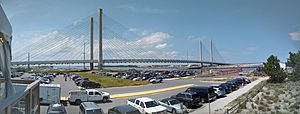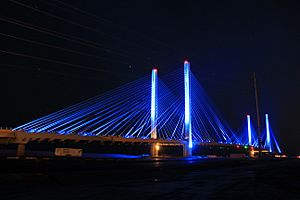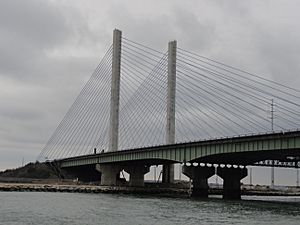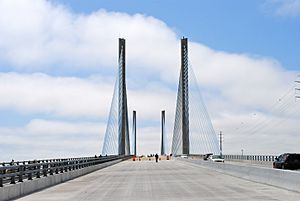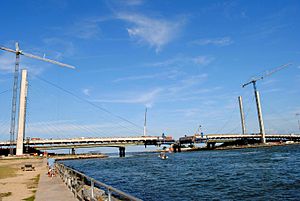Indian River Inlet Bridge facts for kids
Quick facts for kids Indian River Inlet Bridge |
|
|---|---|
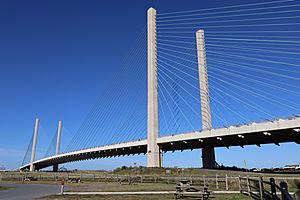
The bridge in 2020
|
|
| Coordinates | 38°36′29″N 75°3′49″W / 38.60806°N 75.06361°W |
| Carries | 4 lanes of |
| Crosses | Indian River Inlet |
| Locale | Sussex County, Delaware |
| Official name | Charles W. Cullen Bridge |
| Maintained by | Delaware Department of Transportation |
| Characteristics | |
| Design | Cable-stayed bridge |
| Total length | 2,600 feet (790 m) |
| Width | 107.66 feet (32.81 m) |
| Longest span | 950 feet (290 m) |
| Clearance below | 45 feet (14 m) |
| History | |
| Opened | January 20, 2012 |
The Indian River Inlet Bridge is a really cool cable-stayed bridge in Sussex County, Delaware. It's also known as the Charles W. Cullen Bridge. This bridge helps people travel on Delaware Route 1 (DE 1) by crossing the Indian River Inlet. It connects the Indian River Bay to the Atlantic Ocean.
Besides cars, the bridge also has paths for Delaware Bicycle Route 1 (Bike Route 1) and people walking. You can find it inside Delaware Seashore State Park, between the towns of Dewey Beach and Bethany Beach. The Delaware Department of Transportation (DelDOT) takes care of the bridge. It's about 2,600 feet (790 m) long and 107.66 feet (32.81 m) wide, with a main section that spans 950 feet (290 m). Boats can pass underneath with 45 feet (14 m) of space.
Before this modern bridge, four other bridges stood here. They were built in 1934, 1940, 1952, and 1965. The 1965 bridge even got an extra part added in 1976. All of them were called the Indian River Inlet Bridge, and most were officially named the Charles W. Cullen Bridge. The 1965 bridge, made of steel, started having problems because the water currents were washing away the ground around its supports. This meant a new, stronger bridge was needed.
| Top - 0-9 A B C D E F G H I J K L M N O P Q R S T U V W X Y Z |
What Makes the Bridge Special?
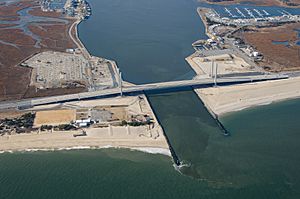
The Indian River Inlet Bridge connects the Atlantic Ocean on one side to the Indian River Bay on the other. It's a key part of Delaware Seashore State Park. The bridge carries four lanes of traffic, two going north and two going south. It also has wide shoulders for safety. On the east side, there's a 12-foot (3.7-meter) wide sidewalk for people to walk or bike.
This bridge is a cable-stayed bridge. This means it uses strong cables connected to tall towers, called pylons, to hold up the bridge deck. There are four pylon towers and 152 cables supporting the bridge. The pylons are built on land, not in the water. This helps stop the water from washing away their foundations.
The bridge is 2,600 feet (790 m) long and 107.66 feet (32.81 m) wide. Its main span is 950 feet (290 m) long. The pylons stand 247.5 feet (75.4 m) above sea level. The bridge has a special fiber-optic system. This system constantly checks the bridge for any problems. It's designed to last for 100 years!
Who Was Charles W. Cullen?
The bridge is officially named the Charles W. Cullen Bridge. This name honors Charles W. Cullen (1865–1948). He was a lawyer and judge from Georgetown. He worked on the Delaware State Highway Commission from 1930 to 1940. He was even its chairman from 1938 to 1939.
During his time, he helped build the second bridge over the Indian River Inlet. That bridge replaced an older wooden one from 1934. The 1940 bridge was dedicated in his name. The current 2012 bridge is the fourth one to carry his name. A special plaque at the bridge's south end explains his dedication to public service.
The plaque says:
This bridge honors Charles West Cullen (1865–1948). He dedicated his life to serving the people of Delaware. From 1930 to 1940, he was on the State Highway Commission. He led it from 1938-1939. While he was chairman, work began on a new bridge for the Indian River Inlet. On May 28, 1940, that bridge was named after him. He worked hard to keep the inlet open and help the Indian River area grow. Two more bridges after that also carried his name. This fifth bridge over the inlet is also named for him. As this bridge serves the public, we remember his lifetime of service.
A Look Back: The Bridge's History
In the early 1900s, more people owned cars. Delaware's beach towns became very popular. This led to building the Ocean Highway (now DE 1, or Coastal Highway). It connected Rehoboth Beach and Bethany Beach. But when it was finished in 1933, there was no way to cross the Indian River Inlet.
The Indian River Inlet was a natural waterway that moved around a lot. From 1928 to 1937, dredging kept it in its current spot. In 1938, the United States Army Corps of Engineers built jetties. These are structures that keep the inlet fixed in place. Once the inlet was stable, building a bridge became possible.
Earlier Bridges Over the Inlet
Five bridges have crossed the Indian River Inlet over time.
- The first was a wooden trestle bridge built in 1934. It quickly wore out because of the salty water.
- It was replaced by a concrete and steel swing bridge in 1940. This was the first one named for Cullen. It cost about $165,900. This bridge collapsed in 1948 due to high tides, strong winds, and ice. The water currents had washed away the ground under its supports.
- Another concrete and steel swing bridge was finished in 1952. This one also became unsafe and closed in 1962 after a storm.
The next bridge was an 860-foot (262-meter) steel girder bridge. Its first part opened in 1965. In 1976, a second part was added. The older part carried northbound traffic, and the new part carried southbound traffic. When this bridge opened in 1965, the inlet was 23 feet (7 meters) deep. But strong currents kept washing away the soil around the bridge's supports. By the late 1980s, divers could even swim under one of the concrete foundations!
Engineers tried to protect the supports with riprap (large rocks) in 1989. But this was only a temporary fix. Officials realized the bridge could be damaged by just one bad storm. It was listed as "structurally deficient," meaning it needed to be replaced. By 1999, the inlet was over 100 feet (30 meters) deep due to the erosion. By 2005, experts thought the bridge would only last 3 to 5 more years. It was expected to close between 2008 and 2011. By 2007, about 14,000 cars used the bridge daily, and twice that many in summer. Closing it would cause huge traffic problems.
Building the Current Bridge
Early Ideas and Challenges
In 2003, officials planned a new bridge. They first thought of a tied-arch design. It would have been 1,000 feet (305 meters) long, with no supports in the water. This would avoid the erosion problems. It was estimated to cost $65 million. But only one company bid on the project, and their price was too high. By 2005, state budget problems and rising costs pushed the price to $200 million.
So, DelDOT changed plans in 2006. They decided on a design–build project for a 1,400-foot (427-meter) cable-stayed bridge. This design also had no supports in the water. Work began on earth ramps for the bridge in 2006. But by 2007, these ramps were moving more than expected. There were also legal issues with how the contract was given out. Because of these problems, DelDOT stopped the project in 2007. They decided to remove the faulty ramps and start over. They would build a longer, 2,600-foot (792-meter) cable-stayed bridge with a new design.
Construction Begins
In August 2008, the company Skanska won the $150-million contract to build the new bridge. They started testing the ground for the supports later that year. In May 2009, the public voted on how the bridge should look. They chose blue cables, slanted pylon tops, and nautical-themed lights.
Construction of the main pylons began in July 2009. By December 2009, work was also starting on the approach roads. In April 2010, they began pouring concrete for the bridge deck. The bridge also received $1.79 million in federal money for its walking and biking paths. By this time, the new bridge was about halfway done.
In February 2011, another company, George & Lynch, got a contract. They were to build the roads leading to the new bridge. They also had to take down the old bridge. A small fire happened at the construction site, but it didn't damage the bridge. Over 250 people worked on building the bridge.
Opening Day
The new Indian River Inlet Bridge opened to southbound traffic on January 20, 2012. Delaware Governor Jack Markell, U.S. Senator Tom Carper, and DelDOT Secretary Shailen Bhatt were the first to drive across. On January 30, 2012, one northbound lane opened.
The bridge was officially dedicated in a public ceremony on May 6, 2012. Visitors could walk across the bridge that day. All four lanes, plus the pedestrian and bicycle walkway, opened completely. Demolition of the old 1965 bridge began in spring 2012 and was finished in spring 2013.
Images for kids


